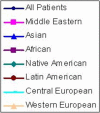BRCA1 and BRCA2 mutations in women of different ethnicities undergoing testing for hereditary breast-ovarian cancer
- PMID: 19241424
- PMCID: PMC2771545
- DOI: 10.1002/cncr.24200
BRCA1 and BRCA2 mutations in women of different ethnicities undergoing testing for hereditary breast-ovarian cancer
Erratum in
- Cancer. 2009 Jun 15;115(12):2804
Abstract
Background: In women at increased risk for breast and ovarian cancer, the identification of a mutation in breast cancer gene 1 (BRCA1) and BRCA2 has important implications for screening and prevention counseling. Uncertainty regarding the role of BRCA1 and BRCA2 testing in high-risk women from diverse ancestral backgrounds exists because of variability in prevalence estimates of deleterious (disease-associated) mutations in non-white populations. In this study, the authors examined the prevalence of BRCA1 and BRCA2 mutations in an ethnically diverse group of women who were referred for genetic testing.
Methods: In this cross-sectional analysis, the prevalence of BRCA1 and BRCA2 mutations was assessed in a group of non-Ashkenazi Jewish women who underwent genetic testing.
Results: From 1996 to 2006, 46,276 women who met study criteria underwent DNA full-sequence analysis of the BRCA1 and BRCA2 genes. Deleterious mutations were identified in 12.5% of women, and recurrent deleterious mutations (prevalence >2%) were identified in all ancestral groups. Women of non-European descent were younger (mean age, 45.9 years; standard deviation [SD], 11.6 years) than European women (mean age, 50 years; SD, 11.9 years; P < .001). Women of African (15.6%; odds ratio [OR], 1.3 [95% confidence interval (95% CI), 1.1-1.5]) and Latin American (14.8%; OR, 1.2 [95% CI, 1.1-1.4]) ancestries had a significantly higher prevalence of deleterious BRCA1 and BRCA2 mutations compared with women of Western European ancestry (12.1%), primarily because of an increased prevalence of BRCA1 mutations in those 2 groups. Non-European ethnicity was associated strongly with having a variant of uncertain significance; however, reclassification decreased variant reporting (from 12.8%-->5.9%), and women of African ancestry experienced the largest decline (58%).
Conclusions: Mutation prevalence was found to be high among women who were referred for clinical BRCA1 and BRCA2 testing, and the risk was similar across diverse ethnicities. BRCA1 and BRCA2 testing is integral to cancer risk assessment in all high-risk women.
Figures
Similar articles
-
Genetic testing in an ethnically diverse cohort of high-risk women: a comparative analysis of BRCA1 and BRCA2 mutations in American families of European and African ancestry.JAMA. 2005 Oct 19;294(15):1925-33. doi: 10.1001/jama.294.15.1925. JAMA. 2005. PMID: 16234499
-
Prevalence and predictors of BRCA1 and BRCA2 mutations in a population-based study of breast cancer in white and black American women ages 35 to 64 years.Cancer Res. 2006 Aug 15;66(16):8297-308. doi: 10.1158/0008-5472.CAN-06-0503. Cancer Res. 2006. PMID: 16912212
-
Racial differences in the use of BRCA1/2 testing among women with a family history of breast or ovarian cancer.JAMA. 2005 Apr 13;293(14):1729-36. doi: 10.1001/jama.293.14.1729. JAMA. 2005. PMID: 15827311
-
Breast cancer genetics in African Americans.Cancer. 2003 Jan 1;97(1 Suppl):236-45. doi: 10.1002/cncr.11019. Cancer. 2003. PMID: 12491487 Review.
-
Identification of germline 185delAG BRCA1 mutations in non-Jewish Americans of Spanish ancestry from the San Luis Valley, Colorado.Cancer. 2003 Aug 1;98(3):597-602. doi: 10.1002/cncr.11533. Cancer. 2003. PMID: 12879478 Review.
Cited by
-
Genetic counseling for hereditary breast and ovarian cancer among Puerto Rican women living in the United States.Rev Recent Clin Trials. 2014;9(4):245-53. doi: 10.2174/1574887110666150127110314. Rev Recent Clin Trials. 2014. PMID: 25626062 Free PMC article. Review.
-
Genetic variants in microRNA and microRNA biogenesis pathway genes and breast cancer risk among women of African ancestry.Hum Genet. 2016 Oct;135(10):1145-59. doi: 10.1007/s00439-016-1707-1. Epub 2016 Jul 5. Hum Genet. 2016. PMID: 27380242 Free PMC article.
-
Clinical decision support tool for breast cancer recurrence prediction using SHAP value in cooperative game theory.Heliyon. 2024 Jan 18;10(2):e24876. doi: 10.1016/j.heliyon.2024.e24876. eCollection 2024 Jan 30. Heliyon. 2024. PMID: 38312672 Free PMC article.
-
Experiences of Patients Undergoing Chemotherapy With Virtual Reality: Mixed Methods Feasibility Study.JMIR Serious Games. 2022 Feb 21;10(1):e29579. doi: 10.2196/29579. JMIR Serious Games. 2022. PMID: 35188474 Free PMC article.
-
Epidemiology and risk factors for ovarian cancer.Prz Menopauzalny. 2023 Jun;22(2):93-104. doi: 10.5114/pm.2023.128661. Epub 2023 Jun 14. Prz Menopauzalny. 2023. PMID: 37674925 Free PMC article. Review.
References
-
- Jemal A, Siegel R, Ward E, Murray T, Xu J, Thun MJ. Cancer Statistics 2007. CA Cancer J Clin. 2007;57(1):43–66. - PubMed
-
- Claus EB, Schildkraut JM, Thompson WD, Risch NJ. The genetic attributable risk of breast and ovarian cancer. Cancer. 1996;77(11):2318–2324. - PubMed
-
- Garber JE, Offit K. Hereditary cancer predisposition syndromes. J Clin Oncol. 2005;23(2):276–292. - PubMed
-
- Rebbeck TR, Friebel T, Lynch HT, et al. Bilateral prophylactic mastectomy reduces breast cancer risk in BRCA1 and BRCA2 mutation carriers: the PROSE study group. J Clin Oncol. 2004;22(6):1055–1062. - PubMed
-
- Pal T, Permuth-Wey J, Holtje T, Sutphen R. BRCA1 and BRCA2 mutations in a study of African American breast cancer patients. Cancer Epidemiol Biomarkers Prev. 2004;13(11 pt 1):1683–1686. - PubMed
MeSH terms
Grants and funding
LinkOut - more resources
Full Text Sources
Medical
Molecular Biology Databases
Miscellaneous



